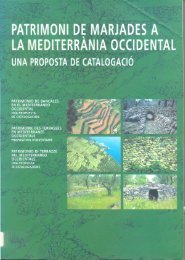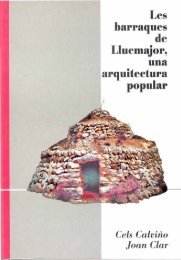La pedra en sec. Materials, eines i tècniques tradicionals a les illes ...
La pedra en sec. Materials, eines i tècniques tradicionals a les illes ...
La pedra en sec. Materials, eines i tècniques tradicionals a les illes ...
Create successful ePaper yourself
Turn your PDF publications into a flip-book with our unique Google optimized e-Paper software.
*** *<br />
** *: 6 6.3.5 DRYSTONE MASONRY STRUCTURES<br />
UNDERGROUND<br />
SPRING PASSAGE<br />
Description<br />
Walled gallery dug to reach the water<br />
table for and the withdrawal of water<br />
by gravity.<br />
Uses<br />
To obtain water for irrigation and for<br />
human and animal consumption.<br />
Site<br />
The springs in the examp<strong>les</strong> are on<br />
plains used for fruit and herbaceous<br />
crops (example 3), next to torr<strong>en</strong>ts<br />
(examp<strong>les</strong> 1 and 2), and built into the<br />
terraces farmland (example 4).<br />
Type of gallery<br />
The examp<strong>les</strong> are either underground<br />
passages dug out of the ground<br />
(examp<strong>les</strong> 3 and 4) or underground<br />
passages which also make use of a<br />
torr<strong>en</strong>t channelling wall as a side wall<br />
(examp<strong>les</strong> 1 and 2).<br />
Gallery roofing<br />
The most common ways of roofing an<br />
underground passage are lintel roofs<br />
using stone slabs (example 3) and<br />
roofs made of stones placed on <strong>en</strong>d<br />
which in most cases form barrel vaults<br />
(examp<strong>les</strong> 1 and 4) or ogival vaults<br />
(example 2).<br />
Access to the gallery<br />
Access is usually made through a single<br />
op<strong>en</strong>ing which can be <strong>en</strong>tered<br />
with varying degrees of ease. Long<br />
underground passages have airshafts<br />
through which material can be lowered<br />
or raised (examp<strong>les</strong> 2, 3 and 4)<br />
and in some cases these shafts have<br />
roofed stairs by a drystone masonry<br />
structure (example 3).<br />
How the Water is Piped Through the<br />
Gallery<br />
Along tiled grooves (examp<strong>les</strong> 1 and<br />
4) or stone channels (examp<strong>les</strong> 2 and<br />
3) running next to one of the walls<br />
(examp<strong>les</strong> 1, 2 and 4) or down the<br />
middle of the underground passage<br />
(example 3).<br />
<strong>Materials</strong><br />
Limestone (examp<strong>les</strong> 1, 2 and 4),<br />
sandstone and limestone (example 3).<br />
Accessory Items<br />
Steps leading down to the op<strong>en</strong>ing of<br />
the underground passage (example<br />
2), water accumulation structures outside<br />
the mine (example 1), and channels<br />
outside the gallery to carry water<br />
to small reservoirs (examp<strong>les</strong> 1 and<br />
4).<br />
Location<br />
Ses Cases Naves, Deia (example 1);<br />
font de sa Capel-Ieta, Valldemossa<br />
(example 2); Son O<strong>les</strong>a, Valldemos-sa<br />
(example 3); Son Moragues, Valldemossa<br />
(example 4) ..••




